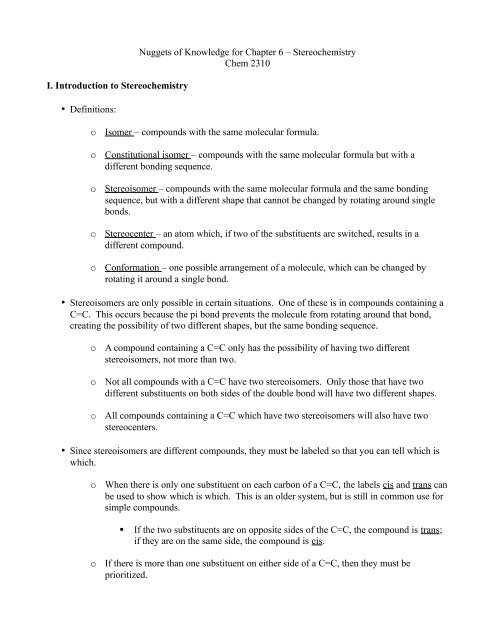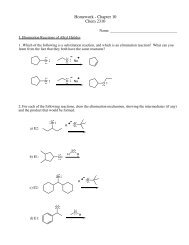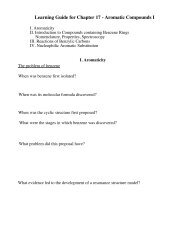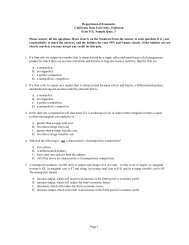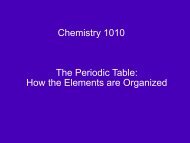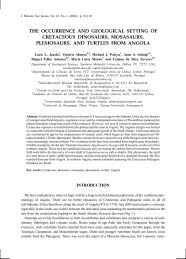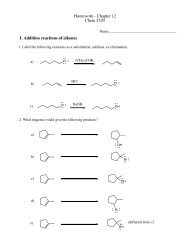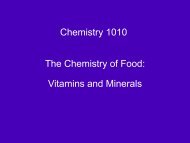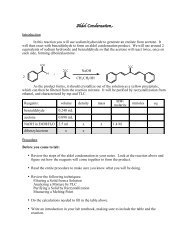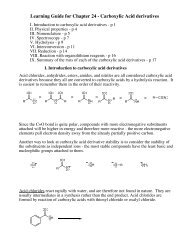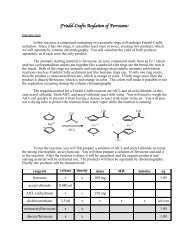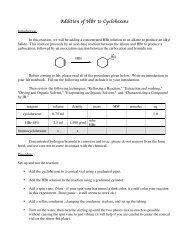Nuggets of Knowledge for Chapter 5 – Nuclear Magnetic ...
Nuggets of Knowledge for Chapter 5 – Nuclear Magnetic ...
Nuggets of Knowledge for Chapter 5 – Nuclear Magnetic ...
You also want an ePaper? Increase the reach of your titles
YUMPU automatically turns print PDFs into web optimized ePapers that Google loves.
I. Introduction to Stereochemistry• Definitions:<strong>Nuggets</strong> <strong>of</strong> <strong>Knowledge</strong> <strong>for</strong> <strong>Chapter</strong> 6 <strong>–</strong> StereochemistryChem 2310oooooIsomer <strong>–</strong> compounds with the same molecular <strong>for</strong>mula.Constitutional isomer <strong>–</strong> compounds with the same molecular <strong>for</strong>mula but with adifferent bonding sequence.Stereoisomer <strong>–</strong> compounds with the same molecular <strong>for</strong>mula and the same bondingsequence, but with a different shape that cannot be changed by rotating around singlebonds.Stereocenter <strong>–</strong> an atom which, if two <strong>of</strong> the substituents are switched, results in adifferent compound.Con<strong>for</strong>mation <strong>–</strong> one possible arrangement <strong>of</strong> a molecule, which can be changed byrotating it around a single bond.• Stereoisomers are only possible in certain situations. One <strong>of</strong> these is in compounds containing aC=C. This occurs because the pi bond prevents the molecule from rotating around that bond,creating the possibility <strong>of</strong> two different shapes, but the same bonding sequence.oooA compound containing a C=C only has the possibility <strong>of</strong> having two differentstereoisomers, not more than two.Not all compounds with a C=C have two stereoisomers. Only those that have twodifferent substituents on both sides <strong>of</strong> the double bond will have two different shapes.All compounds containing a C=C which have two stereoisomers will also have twostereocenters.• Since stereoisomers are different compounds, they must be labeled so that you can tell which iswhich.oWhen there is only one substituent on each carbon <strong>of</strong> a C=C, the labels cis and trans canbe used to show which is which. This is an older system, but is still in common use <strong>for</strong>simple compounds.If the two substituents are on opposite sides <strong>of</strong> the C=C, the compound is trans;if they are on the same side, the compound is cis.oIf there is more than one substituent on either side <strong>of</strong> a C=C, then they must beprioritized.
If the two highest priority substituents are on opposite sides <strong>of</strong> the C=C, then thecompound is labeled E; if they are on the same side <strong>of</strong> the C=C, then thecompound is labeled Z.When prioritizing substituents, use the following rules:• First, look at the atomic mass <strong>of</strong> the atom attached to the C=C. Givehigher priority to the atom <strong>of</strong> highest atomic mass.• If the atoms have the same atomic mass, look at all atoms attached tothem. Order them from largest to smallest atomic mass, and considerthem one by one. Give higher priority to the one that has the highermass first.• If all three atoms attached to the first atom are the same, continue to thenext atom.II. Introduction to Chirality• Definitions:oooooChiral <strong>–</strong> a compound which has a mirror image that is different from the original (has anenantiomer). This is a property <strong>of</strong> a molecule (or any other physical object, <strong>for</strong> thatmatter).Achiral <strong>–</strong> a compound whose mirror image is identical to the original (doesn’t have anenantiomer).Enantiomer <strong>–</strong> compounds which are non-superimposable mirror images <strong>of</strong> each other.This is a relationship between two molecules.Plane <strong>of</strong> symmetry <strong>–</strong> an imaginary plane dividing a molecule in half such that bothhalves are the same.Asymmetric carbon <strong>–</strong> a carbon with four different groups attached to it.• There are three ways to determine if a molecule is chiral.oo1 <strong>–</strong> Superimposable mirror image: If the mirror imagine is not superimposable, themolecule is chiral. If the mirror image is superimposable, the molecule is achiral. Thisis the only completely reliable test.2 <strong>–</strong> Plane <strong>of</strong> symmetry: If there is a plane <strong>of</strong> symmetry in the molecule, it is achiral. Ifthere is not a plane <strong>of</strong> symmetry, the molecule is probably chiral (but there are othermore rare kinds <strong>of</strong> symmetry that might render it achiral).
o3 <strong>–</strong> Asymmetric carbons: If there are no asymmetric carbons in the molecule, it isprobably not chiral (but might be under unusual circumstances). If there is only oneasymmetric carbon in the molecule, it is chiral. If there are two or more asymmetriccarbons in the molecule, it is chiral unless there is a plane <strong>of</strong> symmetry.• Since enantiomers are different compounds, they must also be labeled so that we can tell themapart.oooFirst, prioritize all four groups on the asymmetric carbon, using the same rules asapplied to compounds containing C=C.Second, rotate the molecule so that the last group is pointing away from you.Third, determine the direction going from highest to lowest priority <strong>of</strong> the first threegroups. If the direction is clockwise, the molecule is labeled R. If the direction is counterclockwise, the molecule is labeled S.• When naming compounds, use (R)- or (S)- at the beginning if there is only one stereocenter.oooIf there are two or more, include the number <strong>of</strong> the carbon: (2R,4S).Cis and trans on rings may only be used <strong>for</strong> compounds which are not chiral.Please note: chiral compounds are not always written with their stereochemistryshowing. If the direction <strong>of</strong> the bonds is not specified, it could represent eitherenantiomer, and the R or S <strong>of</strong> that carbon cannot be determined.III. Compounds with two or more stereocenters• When a compound has more than one stereocenter, it can have up to 2 n stereoisomers, where n isthe number <strong>of</strong> stereocenters.• Definitions:oDiastereomer <strong>–</strong> compounds which are stereoisomers, but not enantiomers; they havedifferent shapes but are not mirror images <strong>of</strong> each other.This includes two kinds <strong>of</strong> compounds: those with C=C, and compounds withtwo or more stereocenters in which one is the same and one is different.oMeso compound <strong>–</strong> a compound which contains stereocenters, but in a symmetricalarrangement so that the compound is not chiral.
8. RCA VIDEO OUTPUT: This connection is <strong>for</strong>the RCA video output. While not as high quality asS-video or Component, it is more prevalent in TVs.9. 5.1 CHANNEL AUDIO OUTPUT: These outputsare analog 5.1 sound connections. To use:• Press the OPEN/CLOSE button on the frontpanel and eject the disc tray.• Press the SETUP button on the remote control.• Select SETUP from the onscreen menu using theDIRECTIONAL CONTROL buttons on theremote.• Select SPEAKER SETUP on the onscreen menuusing the DIRECTIONAL CONTROL on theremote.• Set DOWNMIX to OFF.• Set SUBWOOFER to ON.10. HARD COVER PLATE: Do not remove theplate while the hard drive is running.Remote Control Functions1. POWER: Press this button to toggle the KOD-1000 on and<strong>of</strong>f. Using the remote POWER key will put the KOD-1000 instandby. Using the POWER button on the player’s front panelwill shut it down completely.2. PAUSE/PLAY: Press this button to begin play; press againto pause and press it again to resume.3. RECORD: Press this button to record songs from VCD andCD+G discs to the internal hard drive <strong>of</strong> the KOD-1000. Seepage 14 <strong>for</strong> more details.4. FAVORITE: Press button to add songs to the MY FAVOR-ITE folder <strong>of</strong> the KOD-1000. See page 11 <strong>for</strong> more details.5. STOP: Press this button to stop playback.6. KEY RESET: Press this button to return to original key.7. NUMERIC KEYS: Press these buttons to input track andsong selections.8. CLEAR: Press this button to clear any input from the NU-MERIC KEYS.9. PRIORITY: Press this button to move the selected song tothe top <strong>of</strong> the queue.10. VOCAL: Press this button to isolate the left or right audiochannel, or to select mono or stereo output <strong>for</strong> DVDs and CDs.11. MIC VOLUME CONTROL: Press to adjust the audiooutput <strong>of</strong> the attached microphone units.12. LIST: Press this button to see what songs are in the queue.(This function is only supported in the KOD-1000’s hard diskdrive mode.)13. MENU: Press this button to access a DVD’s main menu.Pressing this button in the KOD-1000’s hard disk drive modewill display its Text or Icon menu.14. DIRECTION CONTROL: Press these buttons to navigateselections and menus.15. OK SELECT: Press this button to confirm selections.5
A polarizing filter has tiny slits which only allow the light in that plane to passthrough.Reflected light is usually polarized. Polarized sunglasses contain a polarizingfilter at a right angle to the reflected light, which is why they are good at cuttingdown on glare.oWhen chiral molecules interact with polarized light, they shift the angle <strong>of</strong> the plane <strong>of</strong>the light waves. This angle is called the optical rotation.This angle change is measured by a polarimeter, and is called the opticalrotation. If the angle is positive, then the plane has rotated in the clockwisedirection, while a negative number indicates the counterclockwise direction.The optical rotation <strong>for</strong> a solution depends upon several factors.• The structure <strong>of</strong> the molecule.• The concentration <strong>of</strong> the solution.• The distance the light travels through the solution, called the path length.• The temperature <strong>of</strong> the solution.• The wavelength <strong>of</strong> the light.Since we are most interested in the effect <strong>of</strong> the structure <strong>of</strong> the molecule, weneed to eliminate the effects <strong>of</strong> other factors.• The effect <strong>of</strong> temperature <strong>of</strong> the solution is eliminated by alwaysmeasuring the optical rotation at 25 o C.• The effect <strong>of</strong> different wavelengths <strong>of</strong> light is also eliminated by alwaysusing the D line <strong>of</strong> sodium (a specific frequency given <strong>of</strong>f by excitedsodium atoms).• The optical rotations <strong>of</strong> different chiral compounds at a standardconcentration <strong>of</strong> 1.0 g/ml and standard path length <strong>of</strong> 1.0 decimeter havebeen measured and recorded <strong>–</strong> this is called the specific rotation <strong>for</strong> thatcompound, and has the symbol [α].• To use a different concentration or path length, we use an equation:α = [α] c l, where a is the optical rotation that we have measured.ooThe specific rotations <strong>of</strong> two enantiomers always have the same number, but areopposite in sign. Diastereomers, however, have no relationship between their rotations.There is no relationship between whether a molecule is R or S, and whether it will havea positive or negative rotation. R or S are conventions that we have invented to labelenantiomers, so they don’t tell us about how they will interact with polarized light.
The only thing you can tell is that if the R enantiomer <strong>of</strong> a compound has apositive rotation, the S enantiomer will have a negative rotation, and vice versa.oA solution which rotates the plane <strong>of</strong> polarized light is said to be optically active.A solution <strong>of</strong> one enantiomer <strong>of</strong> a chiral compound will always be opticallyactive <strong>–</strong> this is called an enantiomerically pure solution. A solution <strong>of</strong> an achiralmolecule (such as a meso compound) will always be optically inactive.Equal mixtures <strong>of</strong> two enantiomers will be optically inactive, as the rotationswill exactly cancel each other. Such a solution is called a racemic mixture.• Racemic mixtures are very common in synthesis. Since bothenantiomers are <strong>of</strong> equal energy, they are <strong>for</strong>med in equal amounts.Drugs are <strong>of</strong>ten sold as racemic mixtures.Unequal mixtures <strong>of</strong> two enantiomers will have a rotation proportional to theamount <strong>of</strong> each enantiomer.• Two different values are used to describe this proportion:oooThe percent optical purity (% o.p.) is the rotation <strong>of</strong> the mixtureover the rotation <strong>of</strong> the pure enantiomer. This describes howmuch the optical rotation is reduced by the presence <strong>of</strong> the otherenantiomer.The percent enantiomeric excess (% e.e.) difference is the amount<strong>of</strong> the two enantiomers over the total amount, which is the sameas saying the difference between the percentage <strong>of</strong> the twoenantiomers.The % o.p. And the % e.e. come out to the same value <strong>for</strong> a givenmixture. This is because the % e.e. measures how much <strong>of</strong> thedominant enantiomer is left after the amount that is racemic iscanceled out.Separation <strong>of</strong> Enantiomers• Enantiomerically pure compounds can be obtained from three sources:ooIsolating them from nature: Many chiral compounds exist as pure enantiomers in nature,manufactured by plants and animals.Separation <strong>of</strong> enantiomers: In most cases, when a chiral compound is synthesized in thelaboratory, a racemic mixture is <strong>for</strong>med. These enantiomers can sometimes beseparated to give enantiomerically pure compounds <strong>–</strong> this is called resolution <strong>of</strong>enantiomers.
Since enantiomers have identical physical properties, they can’t be separatedusing techniques like filtering, distillation, chromatography, recrystallization,and so on. Instead, they must be temporarily converted to diastereomers, whichhave different physical properties, separated, and then converted back to theorignal enantiomers.oStereoselective reactions: In some cases, a reaction can use a chiral, enantiomericallypure reagent to cause one <strong>of</strong> the enantiomers to be <strong>for</strong>med in greater amounts than theother. Ideally, this ratio can be maximized to over 99% <strong>of</strong> the desired enantiomer. We will discuss stereoselective reactions in chapter 7.Determination <strong>of</strong> Stereochemical Correlation• There is no way to determine whether a compound has a positive or negative rotation by lookingat the structure <strong>of</strong> the compound. This can only be determined by physically measuring theoptical activity.oIn some compounds, the R is positive and the S is negative, while in others the S ispositive and the R is negative.• It is also impossible to determine whether a compound is R or S by looking at a physical sample<strong>of</strong> a compound. This can only be determined by looking at the structure <strong>of</strong> the compound onpaper.• It is there<strong>for</strong>e difficult to determine whether the enantiomer that measures a positive rotationmatches the R or the S structure <strong>of</strong> that compound.• The task <strong>of</strong> matching up positive and negative rotations with R or S structures <strong>for</strong> a pair <strong>of</strong>enantiomers is called stereochemical correlation. For many years, organic chemists were notable to do this, until finally a method was developed in 1951.oooooFirst, a pure sample <strong>of</strong> either one <strong>of</strong> enantiomers must be obtained.Second, its optical rotation is measured to determine if it is positive or negative.Third, the solution is slowly evaporated to <strong>for</strong>m large, pure crystals.Fourth, x-ray crystallography is per<strong>for</strong>med on the crystal. This allows the threedimensional shape <strong>of</strong> the molecules to be determined.Finally, the stereochemistry <strong>of</strong> the molecules is determined from the three dimensionalshape.• This process <strong>of</strong> obtaining a crystal and doing x-ray crystallography is very difficult and timeconsuming(it was only with the advent <strong>of</strong> computers that it became possible to do one in lessthan a year).oFortunately, once the stereochemical correlation is known <strong>for</strong> one compound, it can beused to obtain others. The molecule is changed in a predictable way, so that the threedimensional structure is still known, and then the optical rotation is measured.


